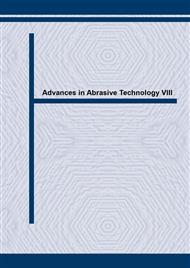p.157
p.163
p.171
p.177
p.183
p.189
p.195
p.201
p.207
Effects of Ultrasonic Vibration in Truing and Dressing of CBN Grinding Wheel Used for Internal Grinding of Small Holes
Abstract:
This paper describes an experimental investigation of the effects of ultrasonic vibration in the truing and dressing of the small CBN grinding wheel used for the internal ultrasonic grinding of small holes. In the precision machining of small holes measuring several millimeters in diameter, improvement in the wheel truing accuracy is significantly levels off when using a single diamond dresser or a rotary GC wheel dresser. In the present work, a new truing and dressing technique was proposed, by which the grinding wheel is ultrasonically vibrated in its axial direction during the truing operation using a rotary GC cup dresser. In order to validate the proposed new technique, experiments were carried out. During experimental operations, the GC cup wheel was traversed along the vitrified CBN grinding wheel axis with an in-feed motion toward the grinding wheel in the wheel radial direction. The influences of the truing parameters on the truing force, the run-out of grinding wheel and the grinding wheel surface properties were investigated. As a result, it was found that applying ultrasonic vibration to the grinding wheel decreased the truing force by more than 22%, and the run-out of grinding wheel decreased from an original value of 150µm to a final one of less than 0.8µm, while that obtained without ultrasonic vibration was more than 1.1µm. As well, better surface properties of the grinding wheel were obtained by the application of ultrasonic vibration.
Info:
Periodical:
Pages:
183-188
Citation:
Online since:
August 2005
Authors:
Keywords:
Price:
Сopyright:
© 2005 Trans Tech Publications Ltd. All Rights Reserved
Share:
Citation:


